 Ford Kuga Service ManualClimate Control » Climate Control (System Operation and Component Description)
Ford Kuga Service ManualClimate Control » Climate Control (System Operation and Component Description)
Component Description
Component Description
Air conditioning compressor
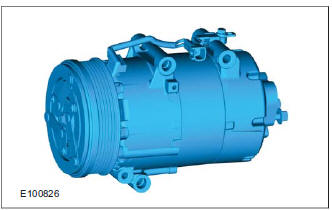
The special feature of a compressor with variable swash plate is that the stroke of the pistons can be varied by means of the variable swash plate.
The swash plate is mounted on a slide rail in the axial direction.
The piston stroke and thus the delivery rate are determined by means of the variable obliqueness of the swash plate.
The obliqueness of the swash plate is dependent upon the chamber pressure and thus on the pressure conditions at the top and bottom of the piston. This is supported by springs in front of and behind the swash plate.
The chamber pressure is determined by the high and low pressure applied to the control valve and by a calibrated orifice bore. If the low pressure is relatively high, the control valve is opened and the chamber pressure is reduced.
If the low pressure is relatively low, the control valve is closed and the chamber pressure is increased. The force due to the chamber pressure exerted on the piston bottom, is higher than the sum of the force due to the low pressure on the piston top and the spring force.
Pollen filter
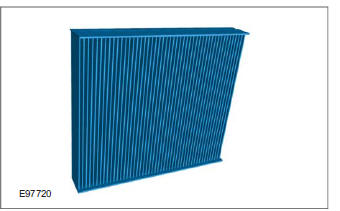
The fresh air flowing into the vehicle through the air inlet housing passes through a pollen filter which is located on the left-hand side of the climate control housing (LHD and RHD) and removes pollen and dust particles measuring 0.003 mm or more.
Control assembly, climate control - vehicles with manual temperature control
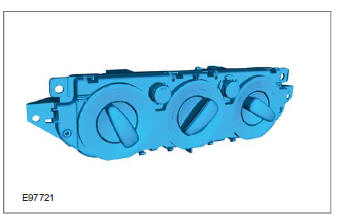
In vehicles with manual temperature control, the heating and air conditioning are operated using three rotary switches. The air distribution flaps are actuated via the air distribution flap/temperature control flap actuating unit, which is connected via a rod to the control assembly for the climate control. The temperature control flap is also actuated via the air distribution flap/temperature control flap actuating unit, which is connected via a cable to the control assembly. In addition, the operating switch for recirculated air mode and the on/off switch for the air conditioning are located on the control assembly.
Control assembly, climate control - vehicles with automatic temperature control
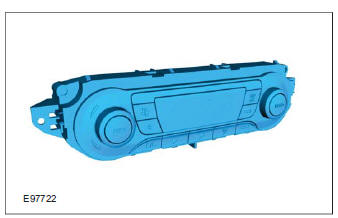
Vehicles with automatic temperature control have a control assembly with the following button operated functions:
- Switching the air conditioning system on and off
- Temperature adjustment for the driver's side/front passenger's side
- Switching the windshield defrost function on and off
- Switching the electronic automatic climate control and the dual mode on and off
- Air distribution
- Blower Control
- Switching off the dual automatic climate control
- Recirculated air control
Control assembly, climate control - vehicles with DVD navigation system with a touch screen
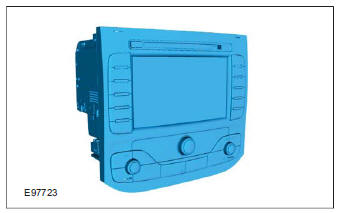
On vehicles with a DVD navigation system with a touch screen, the control buttons for the automatic temperature control (climate control) are integrated in this unit. In addition, all heating and air conditioning functions can be controlled via the touchscreen. The information exchange takes place on the mid-speed CAN bus (MS-CAN).
Climate control module - vehicles with DVD navigation system with a touch screen
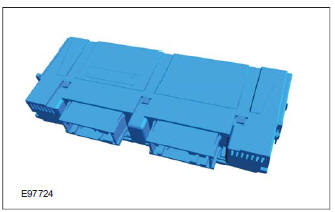
On vehicles with a DVD navigation system with a touch screen, the climate control module is provided as a separate component underneath the DVD navigation unit. It is actuated via control buttons or via the navigation touch screen.
Sun sensor - vehicles with automatic temperature control
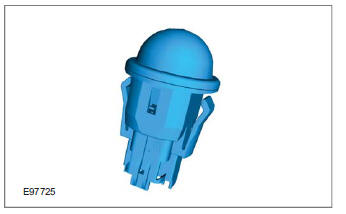
For vehicles with automatic temperature control the sun sensor determines the intensity of the sunload. The sunload serves as an additional parameter for determining the blower air temperature, the air distribution and the blower speed.
In-vehicle temperature sensor
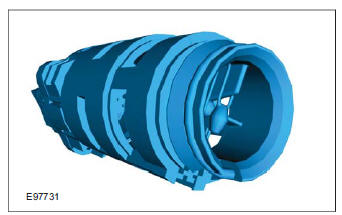
The interior temperature sensor measures the temperature in the passenger compartment and thereby also helps to control the pre-selected interior temperature. This is an NTC resistor.
In order to achieve optimum measurement values, an integrated blower draws air from the interior into the in-vehicle temperature sensor.
Ambient temperature sensor
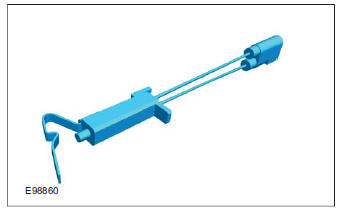
The outside-temperature sensor measures the ambient temperature outside the vehicle. The resistance, and so the voltage drop at the sensor, alter depending on the outside-air temperature.
This is an NTC resistor.
Blower motor
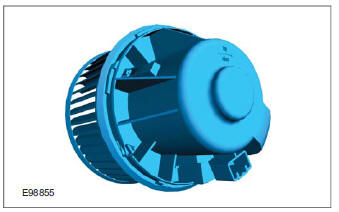
On vehicles with electronic automatic temperature control (EATC), a blower motor with brushes is used.
Blower control module - vehicles equipped with automatic temperature control
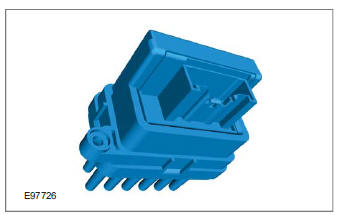
On vehicles with electronic automatic temperature control (EATC) a blower control module is fitted instead of the conventional blower motor resistor.
This is located in the usual position next to the blower motor, so that the cooling fins of the module are cooled by the air flow.
The climate control module regulates the blower control module via a PWM signal, which in turn regulates the voltage at the blower motor to between 3 V and 12.8 V, in an infinitely variable manner.
The blower control module is fitted with a temperature monitor which continuously monitors the internal temperature of the module. If the temperature rises above 105C, the blower motor is switched off until the temperature in the module falls to below 100C.
If the current rises above the value of 26 A +- 3 A defined in the blower control module (e.g. high dynamic pressure in blower housing during fast motorway driving), the current flow through the blower motor is limited by the blower control module, until a safe value is reached. If this value cannot be achieved (e.g. blower motor blocked or partially seized or dynamic pressure in the blower housing permanently too high), the value is limited to 6 A +- 2 A.
Under normal conditions, the blower motor control returns to the normal state.
System Diagram
System Operation
Component Description
Air Conditioning (A/C) Compressor - 2.5L Duratec (147kW/200PS) - VI5(34 626 4)
Air Conditioning (A/C) Compressor to Condenser Discharge Line
Air Conditioning (A/C) Compressor to Condenser Discharge Line - 2.5L Duratec (147kW/200PS) - VI5
Ford Kuga Service Manual
- General Information
- Jacking and Lifting
- Noise, Vibration and Harshness
- Suspension System - General Information
- Climate Control
- Auxiliary Climate Control
- Instrument Cluster and Panel Illumination
- Instrument Cluster
- Horn
- Warning Devices
- Parking Aid
- Charging System - General Information
- Battery, Mounting and Cables
- Generator and Regulator
- Voltage Converter/Inverter
- Information and Entertainment System - General Information
- Information and Entertainment System
- Exterior Lighting
- Interior Lighting
- Daytime Running Lamps (DRL)
- Module Communications Network
- Module Configuration
- Wiring Harnesses
- Anti-Theft - Active
- Anti-Theft - Passive
- Multifunction Electronic Modules
- Front End Body Panels
- Body Closures
- Interior Trim and Ornamentation
- Exterior Trim and Ornamentation
- Rear View Mirrors
- Seating
- Glass, Frames and Mechanisms
- Instrument Panel and Console
- Handles, Locks, Latches and Entry Systems
- Wipers and Washers
- Bumpers
- Safety Belt System
- Supplemental Restraint System
- Body Repairs - General Information
- Body Repairs - Vehicle Specific Information and Tolerance Checks
- Front End Sheet Metal Repairs
- Roof Sheet Metal Repairs
- Side Panel Sheet Metal Repairs
- Rear End Sheet Metal Repairs
- Paint - General Information
- Uni-Body, Subframe and Mounting System
- Suspension System - General Information
- Front Suspension
- Rear Suspension
- Wheels and Tires
- Driveshaft
- Rear Drive Axle/Differential
- Front Drive Halfshafts
- Rear Drive Halfshafts
- Brake System - General Information
- Front Disc Brake
- Rear Disc Brake
- Parking Brake and Actuation
- Hydraulic Brake Actuation
- Power Brake Actuation
- Anti-Lock Control
- Anti-Lock Control - Stability Assist
- Steering System - General Information
- Power Steering
- Steering Linkage
- Steering Column
- Steering Column Switches
- Engine System - General Information
- Engine- 2.5L Duratec (147kW/200PS) - VI5
- Engine Cooling
- Fuel Charging and Controls-2.5L Duratec (147kW/200PS) - VI5
- Fuel Charging and Controls - Turbocharger- 2.5L Duratec (147kW/200PS) - VI5
- Accessory Drive - 2.5L Duratec (147kW/200PS) - VI5
- Starting System- 2.5L Duratec (147kW/200PS) - VI5
- Engine Ignition - 2.5L Duratec (147kW/200PS) - VI5
- Engine Emission Control - 2.5L Duratec (147kW/200PS) - VI5
- Intake Air Distribution and Filtering - 2.5L Duratec (147kW/200PS) - VI5
- Evaporative Emissions
- Electronic Engine Controls
- Automatic Transmission/Transaxle
- Transmission/Transaxle Cooling
- Automatic Transmission/Transaxle External Controls
- Transfer Case
- Exhaust System-
- Fuel System
- Fuel Tank and Lines
- Acceleration Control
- Speed Control
- Climate Control System
- Climate Control
Main Categories
0.026
